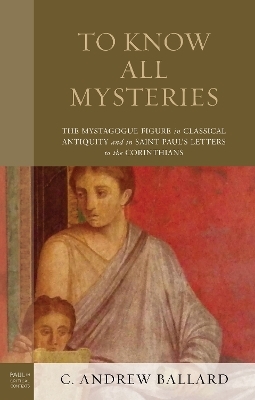
To Know All Mysteries
The Mystagogue Figure in Classical Antiquity and in Saint Paul’s Letters to the Corinthians
Seiten
2022
Lexington Books/Fortress Academic (Verlag)
978-1-9787-1110-5 (ISBN)
Lexington Books/Fortress Academic (Verlag)
978-1-9787-1110-5 (ISBN)
This book examines the way that Paul presents himself as a guide into mysteries, a “mystagogue,” in 1-2 Corinthians. Paul employed the figure of the mystagogue as a strategic tool in his communication with the Corinthians in order to persuade the Corinthians that he was the legitimate mystery teacher for the community.
This book examines the way that Paul presents himself as a guide into mysteries, a “mystagogue,” in 1-2 Corinthians. By describing himself as a type of mystagogue for the community, Paul was following a precedent in both Jewish and non-Jewish sources for invoking mystagogic language to engage in polemics with a rival. In opposition to the precedent, however, Paul understands the mystagogue to be a bi-partite figure—comprised of both foolishness and wisdom simultaneously. C. Andrew Ballard argues that ancient mystagogues were often described in two disparate ways: figures of power, and figures of weakness and foolishness. Paul synthesizes both aspects of the mystagogue in his self-presentation to the Corinthians. The figure of the mystagogue, as a wise-fool, was useful to Paul because it was descriptive not only of his own experience as a suffering, yet authoritative, apostle, but also of the experience of his deity, the suffering and glorified Christ. By presenting himself as both a powerful and foolish mystagogue, Paul could argue that he was a more authentic imitator of Christ than his opponents in Corinth, who boasted in self-exaltation instead of self-humility. In this way, Paul used the character of the mystagogue as a strategic rhetorical tool in his communication with the Corinthians.
This book examines the way that Paul presents himself as a guide into mysteries, a “mystagogue,” in 1-2 Corinthians. By describing himself as a type of mystagogue for the community, Paul was following a precedent in both Jewish and non-Jewish sources for invoking mystagogic language to engage in polemics with a rival. In opposition to the precedent, however, Paul understands the mystagogue to be a bi-partite figure—comprised of both foolishness and wisdom simultaneously. C. Andrew Ballard argues that ancient mystagogues were often described in two disparate ways: figures of power, and figures of weakness and foolishness. Paul synthesizes both aspects of the mystagogue in his self-presentation to the Corinthians. The figure of the mystagogue, as a wise-fool, was useful to Paul because it was descriptive not only of his own experience as a suffering, yet authoritative, apostle, but also of the experience of his deity, the suffering and glorified Christ. By presenting himself as both a powerful and foolish mystagogue, Paul could argue that he was a more authentic imitator of Christ than his opponents in Corinth, who boasted in self-exaltation instead of self-humility. In this way, Paul used the character of the mystagogue as a strategic rhetorical tool in his communication with the Corinthians.
C. Andrew Ballard is adjunct instructor of religion at Fordham University.
Chapter 1: Introduction
Chapter 2: Defining Mystagogues in the Mystery Cults of Antiquity
Chapter 3: Initiation into Philosophy and Truth, Part One: Metaphorical Mystagogues in
Classical, Hellenistic, and Early Imperial Literature
Chapter 4:Initiation into Philosophy and Truth, Part Two: Metaphorical Mystagogues in Jewish Literature of the Hellenistic and Early Imperial Periods
Chapter 5: The Duality of the Mystagogue: Power and Foolishness
Chapter 6: Initiating Paul, Part One: The Appropriation and Disruption of the
Mystagogue in 1 Corinthians
Chapter 7: Initiating Paul, Part Two: The Appropriation and Disruption of the Mystagogue in 2 Corinthians
| Erscheinungsdatum | 30.08.2022 |
|---|---|
| Reihe/Serie | Paul in Critical Contexts |
| Sprache | englisch |
| Maße | 158 x 239 mm |
| Gewicht | 771 g |
| Themenwelt | Geschichte ► Allgemeine Geschichte ► Vor- und Frühgeschichte |
| Geschichte ► Allgemeine Geschichte ► Altertum / Antike | |
| Religion / Theologie ► Christentum ► Kirchengeschichte | |
| Geisteswissenschaften ► Religion / Theologie ► Weitere Religionen | |
| ISBN-10 | 1-9787-1110-7 / 1978711107 |
| ISBN-13 | 978-1-9787-1110-5 / 9781978711105 |
| Zustand | Neuware |
| Haben Sie eine Frage zum Produkt? |
Mehr entdecken
aus dem Bereich
aus dem Bereich
auf den Spuren der frühen Zivilisationen
Buch | Hardcover (2023)
C.H.Beck (Verlag)
CHF 27,95
Konzepte – Methoden – Theorien
Buch | Softcover (2024)
UTB (Verlag)
CHF 55,85
Was Pompeji über uns erzählt
Buch | Hardcover (2023)
Propyläen (Verlag)
CHF 44,75


